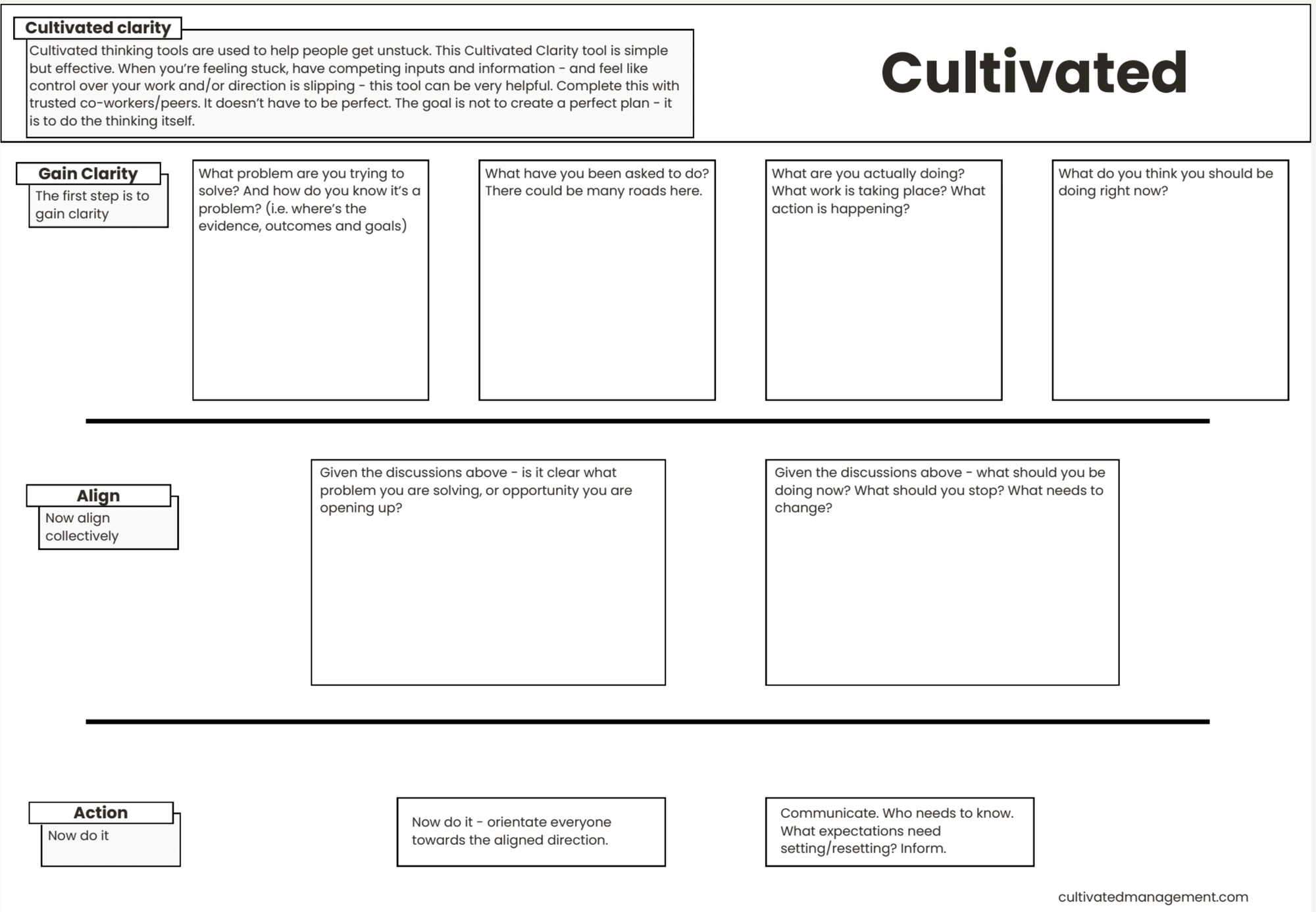
Gain clarity on your work with this simple cheat sheet
I love a good worksheet or tool to help me think through problems, challenges, or those times when I feel stuck. One I use a lot with clients and teams is my Cultivated Clarity Thinking Tool.
👉 Check out A3 Thinking also - a pretty powerful way to solve problems.
It’s remarkably simple — almost obvious. In many ways, it’s just common sense. But in the thick of work, common sense isn’t so common. When I use this tool with teams, they often realise they’ve been solving the wrong problems, doing the wrong work, and wasting time, energy, attention and money.
Its power lies in its simplicity. It’s a deductive tool: a series of questions that narrow down exactly what we should be working on.
In many organisations, everything is treated as “highest priority,” which means nothing really is. Teams get pulled in all directions, juggling too much work, competing demands, and unclear long-term outcomes. It’s chaos — and this tool brings clarity. And you’ll know I crave clarity; it’s the foundation of good work, strong companies, and aligned career growth.
The value isn’t in the tool itself, it’s in the thinking. When we’re busy, overwhelmed, and overworked, clear thinking doesn’t always come easily.
Use this tool with your team, your peers, or on your own. Adapt it as you need. Seek multiple perspectives and evidence where necessary. And yes, it works in your personal life too.
I’ve turned this simple tool into a free PDF you can download here. Read on for further details. It's also available in the store with other great resources.
How the tool works
At the top of the tree is clarity. There are four essential questions to ask about the work you’re doing (and what’s in the backlog). These questions get the thinking started, so you can align and move into action.

Clarity Question 1: What problem are you trying to solve? And how do you know it’s a problem?
You’d be surprised how much time and effort is wasted simply because people aren’t clear about the problem — or the opportunity — they’re addressing. Every problem opens opportunities, and every opportunity creates problems.
The first question gets to the heart of why we do what we do. Define the problem fully: describe it, bring it to life, and give it depth. This clarity galvanises people to solve it and makes it clear what the problem actually is.
We also need to know it’s a problem worth solving and understand how it manifests, using data, insights, or evidence. This helps us know when it’s resolved. The same applies to opportunities: know what “done” looks like.
Without this, teams can drift endlessly because nobody knows what success, completion, or good looks like.
Clarity Question 2: What have you been asked to do?
Often, teams work on things simply because someone higher up asked them to, even when they should be focusing elsewhere.
This question identifies where the demand is coming from. Typically, it comes from multiple directions, bypassing formal processes. Listing everything you’ve been asked to work on helps reveal the chaos.
Clarity Question 3: What are you actually doing?
Next, we audit the work currently happening. Often, people are doing a mix of:
- Work linked to real problems or opportunities
- Work they were asked to do
- Other tasks that aren’t actually needed
For example, I’ve seen a 15-person team working on a product that had been killed off at funding level but nobody told them! Three months of work wasted. And not just work, human's resources of time, energy and attention.
In another central coaching team, 50% of their time went to non-essential “central” activities, leaving just over two days a week for their actual value work.
This question exposes misalignment. Teams often solve the wrong problems or deliver the wrong solutions, or do busy work, or get pulled all over - only to find the work they should be doing isn't getting done.
Clarity Question 4: What do you think you should be doing?
After answering the first three questions, you can now articulate what should actually be happening.
- Which projects/work add real value?
- Which work should stop?
- Which projects need renegotiation or backlog placement?
- Which should be cancelled entirely?
I’ve seen leaders use these questions to eliminate millions of £ in wasted activity and align hundreds of people onto more valuable work. In large organisations, work often continues unnecessarily due to sunk costs — or simply because nobody stops to think or check.
Even in our everyday work lives, we do things that don’t need to be done: a report nobody reads, a meeting you don’t need to attend, a chore that’s unnecessary.
By the end of this process, you should clearly understand:
- The problems you’re solving and why
- How you’ll know they’re solved
- The opportunities being opened
- Where demand is coming from
- What you are actually doing versus what you should stop
Alignment and Action
Once clarity is achieved, capture it to ensure everyone — peers, bosses, stakeholders — is aligned. Then it’s time for action:
- Orient your teams around the clarity. Update work management tools, hold town halls, run one-to-ones, ripple down comms — whatever your structure requires.
- Communicate clearly: explain why these are the right things to focus on, how decisions were made, and provide guidance for stopping unnecessary work.
Clarity without action is just theory – and not all theories have utility. With both, your teams — and your own work — become focused, aligned, and far more effective.
Trinity of Effective Communication Bundle: Get Zero to Keynote, Workshop Mastery, and the Communication Superpower course—all in one powerful package.
